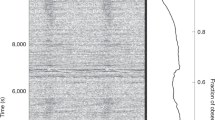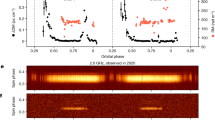Abstract
WITH very few exceptions1, high Galactic latitudes have not been surveyed with sufficient sensitivity to detect millisecond pulsars. Accordingly we have conducted a preliminary sensitive survey at Galactic latitudes b ≥30° using the Arecibo 305-m radiotelescope at a frequency of 430 MHz. Here I report the discovery of a 37.9-ms radio pulsar, PSR1534 + 12, in a 10.1-hour eccentric binary orbit2. Timing analysis constrains the masses of the pulsar and its companion to be 1.32 ± 0.03 M⊙ and 1.36 ± 0.03 M⊙ (where M⊙ is the mass of the Sun). This, together with the high eccentricity (e =0.274) and small orbital diameter (∼2 R⊙ ), indicates that the companion is probably another neutron star, and that the orbital evolution is strongly influenced by effects due to general relativity. The exceptionally high timing accuracy obtainable in PSR1534 + 12, because the pulse is so strong and narrow, will allow general relativity to be tested with unprecedented accuracy. The unique morphology of the pulsar's emission and polarization will make possible the measurement of a previously unconfirmed relativistic effect, the geodetic precession of the pulsar spin-axis.
This is a preview of subscription content, access via your institution
Access options
Subscribe to this journal
Receive 51 print issues and online access
$199.00 per year
only $3.90 per issue
Buy this article
- Purchase on Springer Link
- Instant access to full article PDF
Prices may be subject to local taxes which are calculated during checkout
Similar content being viewed by others
References
Stokes, G. H. et al. Astrophys. J. 311, 694–700 (1986).
Wolszczan, A. IAU Circular No. 5073 (1990).
Wolszczan, A. et al. Nature 337, 531–533 (1989).
Damour, T. & Deruelle, N. Ann. Inst. H. Poincaré (Physique Théoretique) 44, 263 (1986).
Taylor, J. H. & Weisberg, J. M. Astrophys. J. 345, 434–450 (1989).
Smarr, L. L. & Blandford, R. Astrophys. J. 207, 574–588 (1976).
van den Heuvel, E. P. J. & Taam, R. E. Nature 309, 235–237 (1984).
Nagase, F. Publs astron. Soc. Japan 41, 1–79 (1989).
Anderson, S. B., Gorham, P. W., Kulkarni, S. R., Prince, T. A. & Wolszczan, A. Nature 346, 42–44 (1990).
Lyne, A. G. & Bailes, M. Mon. Not. R. astr. Soc. 246, 15P–17P (1990).
Ryba, M. F. & Taylor, J. H. Astrophys. J. 371, in press.
Baym, G. & Pethick, C. J. Ann. Rev. astr. Astrophys. 17, 415–443 (1979).
Woosley, S. E. in The Origin and Evolution of Neutron Stars, IAU Symp. 125 (eds Helfand, D. J. & Huang, J. H.) 255–272 (Reidel, Dordrecht, 1986).
Flannery, B. P. & van den Heuvel, E. P. J. Astr. Astrophys. 39, 61–67 (1975).
Habets, G. M. H. J. Astr. Astrophys. 167, 61–76 (1986).
Hills, J. G. Astrophys. J. 267, 322–333 (1983).
Burrows, A. & Woosley, S. E. Astrophys. J. 308, 680–684 (1986).
Weisberg, J. M., Romani, R. W. & Taylor, J. H. Astrophys. J. 347, 1030–1033 (1989).
Cordes, J. M., Wasserman, I. & Blaskiewicz, M. Astrophys. J. 349, 546–552 (1990).
Bhattacharya, D. & Srinivasan, G. Curr. Sci. 55, 327–330 (1986).
Kulkarni, S. R. & Narayan, R. Astrophys. J. 335, 755–769 (1988).
Author information
Authors and Affiliations
Rights and permissions
About this article
Cite this article
Wolszczan, A. A nearby 37.9-ms radio pulsar in a relativistic binary system. Nature 350, 688–690 (1991). https://doi.org/10.1038/350688a0
Received:
Accepted:
Issue Date:
DOI: https://doi.org/10.1038/350688a0
This article is cited by
-
Orbital Decay of a Binary System Consisting of Spin-Down Neutron Stars
Astrophysics and Space Science (2004)
Comments
By submitting a comment you agree to abide by our Terms and Community Guidelines. If you find something abusive or that does not comply with our terms or guidelines please flag it as inappropriate.



